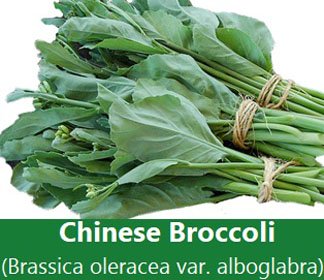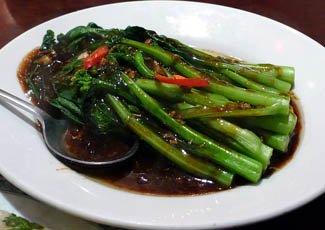Chinese Broccoli Nutrition Facts
Chinese broccoli (gai lan, 芥藍) is a nutritious leafy green vegetable in the Brassica family cultivated for its strong-flavored, young flowering stems.
It is also known as Chinese flowering broccoli (花芥藍), broccoli de chine (French), Chinese kale, and white flowering broccoli. The literal meaning of Gai Lan is "mustard orchid," which describes the subtle mustardy flavor of the leaves.
Botanical name: Brassica oleracea var. alboglabra.

|
Gai lan is a small, annual cool-season crop with some frost tolerance. The optimum temperature for rapid growth is 18-28°C.
It requires well-drained, organic matter-rich fertile soil and an optimum pH of between 6.0 and 7.0 to flourish.
Shoots with compact florets and small leaves are ready for harvesting in 30-50 days from the seedling stage. The main or terminal shoot on each plant is cut to leave buds on the stem for the subsequent development of auxiliary shoots.
Its stalks, leaves, and unopened flower buds are all edible. Chinese broccoli has a slightly bitter taste and is used in soups, stir-fries, or eaten as a steamed vegetable.
Young flowering stems are selected with compact flower heads and small leaves, and cut to lengths of 15 to 20 cm with a sharp knife.
Normally, farmers do 2-3 harvests in a season from each plant to prevent bolting and toughening, particularly in summer. Harvesting should be done well before the buds begin to open.
Chinese Broccoli Health Benefits
Chinese broccoli is one of the most popular greens in mainland China and Japan. Its juicy stems, flower heads, and leaves are storehouses of several phytonutrients, minerals, and vitamins.
Gai lan is a low-calorie leafy vegetable, carrying just 26 calories per 3.5 oz (100g) and only 0.76 mg of fat. Nonetheless, it contains several vital antioxidants that have proven health benefits against chronic diseases and certain cancers.
Gai lan is a very rich natural source of vitamin K (phylloquinone), comprising 89.1 μg or 74% of RDA. Vitamin K promotes bone-strengthening function through its action on osteoblastic cells. It also has an established role in preventing Alzheimer's disease by limiting neuron damage in the human brain.
Gai lan is a member of the Crucifer (mustard) family of greens; hence, it is a naturally rich source of antioxidants like indoles and sulforaphane, as well as flavonoids like carotenes, lutein, and zeaxanthin.
Indoles, mainly di-indolyl-methane (DIM) and sulforaphane, are found to offer protection against breast, colon, prostate, and ovarian cancers by inhibiting cancer-cell growth and exerting cytotoxic effects on cancer cells.
Fresh Chinese broccoli contains 104 μg of natural folates (about 26% of RDA), more than broccoli and rapini (21% of RDA). Inside the human cell, folates are involved in DNA synthesis and cell division. A diet rich in natural folates can help prevent neural tube defects in newborn babies.
It is a good source of vitamin C; 100 fresh leaves provide 29.6 mg (45% of RDA). Vitamin C (ascorbic acid) is a powerful natural antioxidant that offers protection against free oxygen radicals attacking the body and flu-like viral infections.
Chinese broccoli heads consist of 1720 IU (57% RDA) of vitamin A. Additionally, it contains natural pigment compounds like carotenes, lutein, and zeaxanthin in ample amounts.
Together with flavonoids, vitamin A plays an essential role in the vitality of oral cavity mucosa, skin, and hair. It is also an essential component for good night vision. Consumption of natural foods rich in flavonoids has been found to offer protection against lung, esophagus, and oral cavity cancers.
Fresh Chinese broccoli greens are an excellent source of several essential B-complex groups of vitamins such as riboflavin, pyridoxine, thiamin, and minerals such as calcium, iron, potassium, zinc, magnesium, selenium, and manganese.
Scientists recommend regular inclusion of greens like gai lan in the diet to protect against osteoarthritis, weak bones (osteoporosis), iron deficiency anemia, as well as cardiovascular diseases (CVD), colon, and prostate cancers.
| Principle | Nutrient Value | Percent of RDA |
|---|---|---|
| Energy | 26 Kcal | 1% |
| Carbohydrates | 4.67 g | 3.6% |
| Protein | 1.2 g | 2% |
| Total Fat | 0.76 g | 3.8% |
| Cholesterol | 0 mg | 0% |
| Dietary Fiber | 2.6 g | 7% |
| Vitamins | ||
| Folates | 104 μg | 26% |
| Niacin | 0.459 mg | 3% |
| Pyridoxine | 0.074 mg | 6% |
| Riboflavin | 0.153 mg | 12% |
| Thiamin | 0.1 mg | 8.3% |
| Vitamin A | 1720 IU | 57% |
| Vitamin C | 29.6 mg | 45.5% |
| Vitamin K | 89.1 μg | 74.25% |
| Electrolytes | ||
| Sodium | 7 mg | 0.5% |
| Potassium | 274 mg | 6% |
| Minerals | ||
| Calcium | 105 mg | 10.5% |
| Copper | 0.064 mg | 7% |
| Iron | 0.59 mg | 7% |
| Magnesium | 19 mg | 5% |
| Selenium | 1.4 µg | 2.5% |
| Zinc | 0.41 mg | 4% |
| Phyto-nutrients | ||
| Carotene-ß | 1030 μg | -- |
| Lutein+zeaxanthin | 957 µg | -- |
Selection
Gai lan is a popular cabbage vegetable native to mainland China. It is one of the most popular leafy vegetables found at local markets across East Asia and Southeast Asia.
Today, along with similar seasonal greens such as choy sum (Chinese flowering broccoli), komatsuna, tatsoi, etc., it is also found at specialty grocers and Asian markets in Europe, Australia, and the United States.
Chinese broccoli is usually grown as a fall, winter, or early spring crop. Fresh greens begin arriving at markets, peaking from fall through spring. It can be grown year-round in greenhouse practice.
Harvest gai lan before the flowers open, although a few open flowers won't decrease the quality of the vegetable.
Harvest stalks in the early morning to minimize water stress, and tie them into bunches of 5 to 7 plants. The main stem should be 1.5-2.0 cm wide at the base and 4-6 inches long.
Look for fresh greens featuring crispy, pale green stems and deep blue-green leaves. A few open flowers won't decrease the quality of the vegetable. Avoid stems with wilt, spotted or discolored leaves, and bolted florets.
Storage
Chinese broccoli experiences a quick loss of moisture, given the large surface area of its leaves, if kept exposed to higher temperatures. At home, store the leaves in the refrigerator soon after buying. Place them inside a breathable polythene bag in a crisper drawer. Maintain a relative humidity of 95-100%.
Although they can be stored for up to 3 days in cold storage, fresh Chinese broccoli greens should be used as soon as possible to obtain maximum nutritional benefits.
Preparation and Serving Methods
Chinese broccoli features very prominently in Cantonese, Thai, Malay, Korean, and Vietnamese cooking. Fresh leaves, flower buds, and stems are used in a variety of cuisines all over East Asia and in the U.S.
Before cooking, wash the leaves thoroughly in clean running water to remove sand or any insecticide residues.
Peel stalks that are more than 1/2-inch in diameter, then halve lengthwise. Chop the stalks and leaves into 2.5-inch long pieces, keeping the stalk ends separate from the leaves.
Tender leaves and flower tips of Gai Lan can be consumed raw. But larger leaves and stems impart a slightly bitter taste and are usually enjoyed stir-fried, boiled, blanched, braised, or steamed. Its pungent, mustardy flavor is somewhat toned down if cooked with aromatics or light sauces to help balance out the flavor.
Gai Lan complements well with sauces such as garlic, oyster, or soy. It mixes well with spices like ginger, meats such as pork and beef, fish, mushrooms, pasta, rice, pine nuts, bell pepper, and basil.
Here are some serving tips:
 |
| Gai lan (stir-fry Chinese broccoli/kale). Courtesy: Ewan Munro |
Fresh tender gai lan is enjoyed raw in salads, mixed with other seasonal greens and vegetables.
Chinese broccoli may be preserved as a pickled vegetable (Gat kimchi 갓김치), which is a popular recipe in Korea and China. It can be substituted for choy sum, broccolini, bok choy, etc., for a more highly flavored version of kimchi.
It complements well when added to soups and stews or braised with aromatic spices such as garlic, star anise, garlic, and scallions.
The leaves and stems can be stir-fried with other vegetables, mixed into noodle soups, or lightly sautéed and served with savory main dishes.
They can also be used as a wrap for cooked meats, herbs, and sauces, mixed into pot pies, or blended into green juices and smoothies.
Safety profile
Reheating Gai lan leftovers may cause the conversion of nitrates to nitrites and nitrosamines by certain bacteria that thrive on prepared nitrate-rich foods, such as Gai lan, mustard, spinach, and many other green vegetables. These poisonous compounds may prove harmful to health.
Phytates and dietary fiber present in Chinese kale may interfere with the bioavailability of iron, calcium, and magnesium.
Chinese broccoli, being a Brassica family vegetable, contains oxalic acid, a naturally occurring substance found in some vegetables that may crystallize as oxalate stones in the urinary tract in some people. People with known oxalate urinary tract stones are advised to avoid eating vegetables belonging to the Crucifer family. Adequate intake of water is, therefore, necessary to maintain normal urine output.
Chinese broccoli may also contain goitrogens which may interfere with thyroid hormone production and can cause thyroxin hormone deficiency in individuals with thyroid dysfunction.
(Medical Disclaimer: The information and reference guides on this website are intended solely for the general information of the reader. It is not to be used to diagnose health problems or for treatment purposes. It is not a substitute for medical care provided by a licensed and qualified health professional. Please consult your health care provider for any advice on medications.)
You may also like to read ≻≻
≺≺ Komatsuna Nutrition facts.
≺≺ Choy Sum (Chinese flowering cabbage) Health benefits.
≺≺ Napa cabbage Health benefits.
≺≺ Bok choy Health benefits.
≺≺ Broccoli rabe Health benefits.
≺≺ Mustard-greens Health benefits.
≺≺ Back to Vegetables from Chinese broccoli. Visit here for an impressive list of vegetables with complete illustrations of their nutrition facts and health benefits.
≺≺ Back to Home page.
Further reading:
Stanford School of Medicine Cancer information Page- Nutrition to Reduce Cancer Risk (Link opens in new window).
Kitazawa Seed Company (Link opens in new window).
Specialty Produce- Gai lan (Link opens in new window).